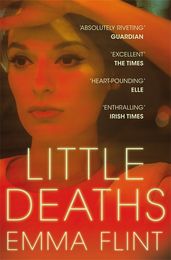What makes the 'perfect' murder?
Emma Flint, author of gripping debut thriller Little Deaths, explores what it is that makes a real-life crime stick in the public imagination.

Emma Flint, author of gripping debut thriller Little Deaths, explores what it is that makes a real-life crime stick in the public imagination and asks whether popular tastes in murder have changed over time.
George Orwell, in his tongue-in-cheek essay The Decline of the English Murder (1946), identified a number of characteristics of 'what would be, from a News of the World reader’s point of view, the ‘perfect’ murder'.
Orwell’s perfect murder would be entirely domestic. The murderer would be 'a little man of the professional class…living an intensely respectable life somewhere in the suburbs, and preferably in a semi-detached house, which will allow the neighbours to hear suspicious sounds through the wall.' The murder would be carefully planned and executed. The motive would be adultery; the weapon, poison.
Watching the excellent Rillington Place, based on the true story of serial killer John Christie, on BBC1 this month, I realised that by 1946, Christie had already embarked upon his murderous career.
I wondered if Christie had read Orwell’s essay and if he was struck by the irony. Christie was a little man, living ‘an intensely respectable life’ – at least on the surface – in what was then a run-down suburb of west London. His motive wasn’t adultery, but it was sexual; his weapon wasn’t poison, but gas. As with poison, gas allowed Christie to sit back and watch his victims dying, and enjoy the power that gave him over them.
In the seventy years since Orwell wrote those words, popular tastes in murder have changed. The cases which have made the most sensational headlines since the end of the Second World War – Haigh, Brady and Hindley, Nilsen, Sutcliffe, the Wests – were characterised by their brutality. Christie himself became infamous because of the number of his victims, and because of the miscarriage of justice that resulted in the death of Timothy Evans.
None of these men and women had the simple old-fashioned excuse of adultery: their motives were incomprehensible to readers. Many people have affairs or want a way out of an unhappy marriage; however, these men and women were driven by compulsions that most of us will never come close to experiencing. They killed as part of a folie à deux; because they were sadists who wanted to inflict harm or to experience how it felt to kill; because they were lonely and craved companionship, even that of a dead body.
Theirs are not classic crimes, in the sense that Orwell wrote about them. These men and women became infamous because of the degree of violence and cruelty they employed.
None of them chose poison: Haigh made headlines because he used sulphuric acid as a method of body disposal and claimed to be a vampire; Brady and Hindley because they tape-recorded themselves torturing children; Nilsen because he killed 15 men, most of whom were never even reported missing, and because he boiled the flesh of his last victims and attempted to flush it down the drain. Peter Sutcliffe’s crimes made headlines because he created a climate of terror among women throughout the north of England; what Fred and Rose West did was horrific partly because they raped and murdered their own children over a period of years.
These dark and bloody details – beyond the imagination of most of us until we see them in print – these are the details that sell newspapers.
But Orwell’s emphasis on the domestic aspect of murders brings this most evil and heinous of crimes back within the sphere of our imagination. The violent details of the crimes themselves are arguably less interesting than the way that ordinary life can co-exist with the business of murder.
For years before his arrest in 1983, Dennis Nilsen got the bus from a respectable North London suburb to his civil service job, walked his dog and helped organise the annual office party, then came home in the evening to wash and sleep with the bodies of his victims.
In 1914, George Joseph Smith drowned his wife in the bathtub, and then ran out to buy a bag of tomatoes before coming back to ‘discover’ her body.
In 1921, Major Armstrong attempted to poison a business rival by adding arsenic to a teatime scone and passed it to him with the words ‘excuse fingers’.
If a classic book is one which can be reinterpreted and read anew by each generation, surely a classic crime is one that every era can relate to. It’s the convergence of the ordinary – even the bland – with the extremity of murder, that I’d argue makes these crimes ‘classic’, makes them stick in the memory.
While Brady and Hindley, the Wests, Sutcliffe and Nilsen committed atrocities that are beyond the imagination of most of us, Armstrong and his scones, Smith and his baths and his bag of tomatoes – these details enable us to imagine that these crimes could happen next door. They bring the idea of murder home.
Little Deaths
by Emma Flint
A phenomenal achievement.' – Jeffrey Deaver
It's every mother's worst nightmare. But Ruth Malone is not like other mothers.
It's the summer of 1965, and the streets of Queens, New York shimmer in a heatwave. Ruth Malone wakes to find a bedroom window wide open and her two young children missing. After a desperate search, the police make a horrifying discovery. Ruth Malone is enthralling, challenging and secretive - is she really capable of murder?
Watch Emma reading from Little Deaths
Discover the best thriller books that will keep you hooked



